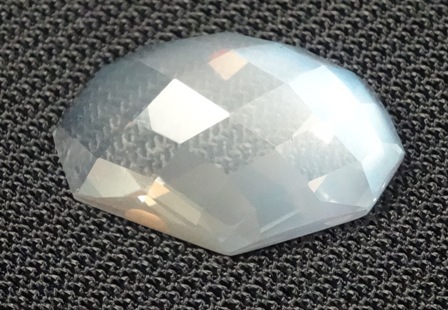
Faceted Moonstone
Something that is steadily growing in popularity is moonstone. Moonstone, however, is not a newly discovered gemstone, and it’s been entrancing beholders with the mysterious, silken light of a full moon for hundreds, if not thousands of years. Ancient Hindus and Romans once believed moonstone was actually crystallized moonlight. Every myth and legend associated with the moon has been projected upon moonstone by those cultures who encountered it. The soft glow emanating from beneath the surface of moonstone can be both soothing and enchanting, and moonstone has long been regarded as a fertility charm.
When the National Association of Jewelers developed the United States’ official birthstone list in 1912, moonstone was chosen as the alternate to pearl for the month of June. This act was built upon the tradition of substituting moonstone for pearl in Ayurvedic medicine. Moonstone’s popularity spiked during the Art Nouveau, but it has waned over the years, primarily because of the ready availability of low-quality material or other kinds of minerals erroneously marketed as “moonstone. Recently, however, moonstone is coming back in vogue as people are becoming aware of what moonstone should really look like.
Fine moonstone is a sight to behold and of no mean value. The lunar glow of moonstone is known by the gemological term “adularescence.” The adularescent display of a moonstone can be white, gray, orange, or blue. Something marketed as “rainbow moonstone” is actually a variety of labradorite, but the price variance between this and fine grades of moonstone are negligible. Body colors can range from milky white to chocolate brown to pink to green.

A semi-transparent, rose-cut moonstone.
The color of the optical phenomenon is the major driving force of price, with blue being the most valuable. Degree of transparency and body color are next in line. The closer to transparent you can get, the more readily visible the adularescence will be, and so the price will go up. Moonstone with a true body color (not just the color of the adularescence) is becoming increasingly rare and comparatively expensive, although it is still a bargain when weighed against many other gemstones.
From a technical standpoint, moonstone is a member of the Feldspar Group of minerals. Collectively, feldspar makes up an estimated 60% of Earth’s crust. There are only nine varieties of feldspar that are considered gem quality. Like the Garnet Group, many of the gem types of feldspar are mixtures of pure group subspecies, like albite, anorthite, and orthoclase.
Moonstone is a mixture of the feldspar minerals albite and orthoclase. Alternating parallel layers of albite within an orthoclase matrix rebound light between one another, causing adularescence. The size of, distance between, and overall orderliness of the sheet-layers in a particular stone affects the color and quality its adularescence.
As with many gems that are not diamonds, rubies, or sapphires, moonstone jewelry requires a little extra care than some others. Moonstone should never be steam cleaned or put in an ultrasonic cleaner. It is a fragile gem that cleaves readily and is sensitive to both heat and chemicals. A soft, damp cloth is the best choice, but if there is build-up behind a set stone, you should use a mild detergent and a soft toothbrush to clean it away. Like opals, moonstone is one of those gems best stored in a separate bag or compartment from other jewelry to keep it from getting scratched or chipped if it gets knocked against other jewelry you own.
Moonstone’s allure is powerful. Every piece of moonstone in my cases captures attention from almost every customer browsing because it looks so unique amongst other colored stones. It may not have a strong body color, and most material is cut en cabochon, but the billowy, floating light shown by fine moonstone is so utterly different from everything else around it. You can’t help but be charmed by it.
Tags: Art Nouveau, gemstones, jewelry, june birthstone, minerals, moonstone, optical phenomenon, pearl, popularity